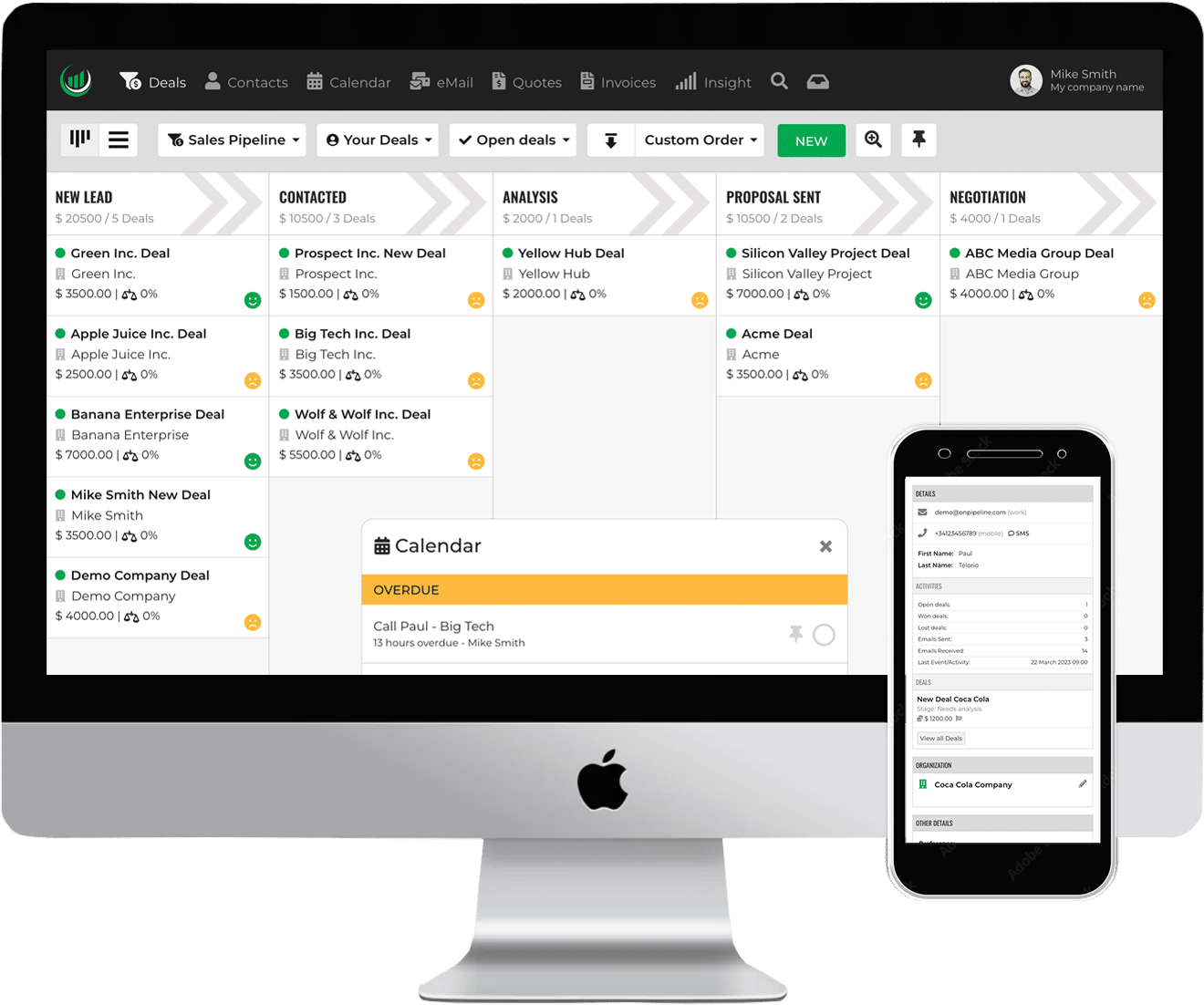Let’s walk through the numbers you need, why they matter, and how to use them in day-to-day decisions.
Start with two simple inputs
Pick a time window. Maybe you aim for the quarter (90 days) or the month (30). Then grab two reliable numbers from your CRM: your win rate and your average deal value (ARPA).
Now do the first two calculations:
1. Deals needed
Revenue target ÷ ARPA
If you target $500,000 and your ARPA is $5,000, you need 100 deals.
2. Required pipeline value
Revenue target ÷ Win rate
If your win rate is 25%, you need $2,000,000 in active pipeline to land that $500,000.
That already changes the conversation. You no longer say “we need more pipeline.” You say “we need $2M this quarter.”
Turn dollars into work
How many opportunities do you need?
Dollars don’t create activity, opportunities do. So translate your plan into volume:
Recommended opportunities in progress = Deals needed ÷ Win rate
Using the example above, 100 deals with a 25% win rate means you should carry ~400 opportunities.
This number guides weekly priorities. If you carry 220 opportunities, you can’t expect to hit 100 deals. You either increase opportunity count or improve conversion.
Time matters
You can’t open a deal on day 85 of the quarter and expect to close it by day 90 if your sales cycle is 60 days. The calendar controls your outcomes as much as your math.
Use two more inputs:
- Sales cycle (days) and
- Target period (days)
With those, you answer three critical questions.
1) How many opportunities should stay active on average?
Think of this as your pipeline “work in progress” (WIP). You spread your deal goal across the period and account for cycle length and win rate:
Average WIP needed ≈ (Deals needed ÷ Period days) × (Sales cycle ÷ Win rate)
This tells you how many opportunities you need in motion at any given time to stay on pace.
2) When do you need to start new opportunities?
You only have so many days to start something that can still close deals inside the period:
Latest start window (cutoff) = Target period − Sales cycle
If your cycle is 60 days and your quarter is 90, you have 30 days to create new opportunities that can still close this quarter. After that, new work fuels the next period.
3) How many new opportunities per week do you need?
You know the volume you need before the cutoff. Spread it over the remaining weeks:
New opps per week (until cutoff) ≈ Recommended opportunities ÷ Weeks before cutoff
If you need 400 opportunities and you have 6 weeks before the cutoff, you target ~67 new opportunities per week. Now your activity plan lines up with your revenue plan.
A quick example
Let’s plug these into a simple table.
| Input | Value |
| Revenue target | $500,000 |
| Win rate | 25% |
| ARPA | $5,000 |
| Sales cycle | 60 days |
| Target period | 90 days |
Now compute the plan.
| Output | Formula | Result |
| Deals needed | 500,000 ÷ 5,000 | 100 |
| Required pipeline value | 500,000 ÷ 0.25 | $2,000,000 |
| Recommended opps in progress | 100 ÷ 0.25 | ~400 |
| Average WIP needed | (100 ÷ 90) × (60 ÷ 0.25) | ~267 |
| Latest start window | 90 − 60 | 30 days |
| New opps per week (to cutoff) | 400 ÷ (30 ÷ 7) | ~93 |
This plan gives you an honest picture. You don’t guess; you schedule. If ~93 new opps per week sounds high, you adjust earlier in the funnel (lead gen, qualification, partner motion) or you change the mix (smaller deals for short-term recovery vs larger, longer-cycle deals for the next period).
How to use these numbers in real life
Coach by math, not by vibes. If a rep needs 40 active opportunities to stay on pace but carries 18, you don’t wait for end-of-month. You coach on top-of-funnel, not just on closing technique.
Prioritize earlier. When you approach the cutoff, you focus on fast-moving motions: smaller deal sizes, repeatable use cases, high-intent segments, and known champions. You keep long-cycle deals, but you assign them to the next period’s plan.
Balance quality and quantity. If your new opps per week number looks scary, don’t flood the top of the funnel with low-quality deals. Improve win rate and ARPA in parallel. A small lift in win rate from 25% to 28% reduces your required pipeline and your weekly creation load.
Inspect stage conversion, not just the final win rate. The formulas above use win rate as a single number. In reality, each stage leaks. When you see a stage conversion drop, you know where to fix enablement and messaging.
You can sharpen forecasts and activity targets with two more lenses:
| Metric | How it helps |
| Lead → Opportunity rate | Converts your weekly new-opps target into a weekly lead target. If you convert 12% of leads into opps and you need 93 opps per week, you need ~775 leads. |
| Sales velocity = (No. of opportunities × Win rate × ARPA) ÷ Sales cycle | Shows how fast your pipeline turns into revenue. When you shorten the cycle or increase win rate, velocity climbs. You reach the same revenue with less pipeline or reach more revenue with the same pipeline. |
These two metrics keep marketing, SDRs, and sales managers in sync. Everyone sees the same math and rows in the same direction.
Common gotchas (and how to avoid them)
Don’t treat “coverage” as a magic multiple. You don’t need 3× or 5× by superstition—you need the pipeline that your actual win rate demands. If your numbers imply 4×, call it 4×; if they imply 2.2×, call it 2.2×. Let math lead.
Don’t ignore cycle length. If you need deals this quarter and your cycle is long, you either start earlier or shift part of the goal to smaller, faster motions. Hope won’t compress a 60-day cycle into 20.
Don’t blend periods. When you plan for 90 days, measure and coach inside that 90-day window. Rolling forecasts have value, but reps need clear period-bound goals and activity plans.
Wrap it up
When you calculate pipeline targets with these formulas, you turn pressure into clarity. You know how many deals you need, how much pipeline you must carry, how many opportunities you need in play, and by when you must create them. You don’t guess; you steer.
If you want the numbers in seconds, use the free Sales Pipeline Calculator. If you prefer spreadsheets, lift the formulas and build a sheet for your team. Either way, do the math, share the plan, and run your quarter with intent.


